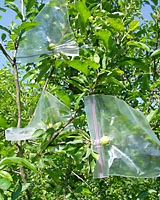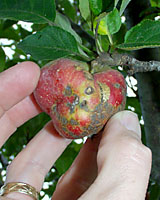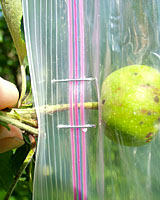Terry L. Ettinger Horticulture Consulting Services
Meeting The Needs Of Today With A Vision For The Future
Question of the Week
Bagging Apples for Perfect Fruit
 Q. We moved into an old house several years ago and were
excited to discover three medium-sized apple trees in the backyard.
Now that we've finished fixing up the house, we're ready to tackle
the landscape and start caring for the apple trees so that they'll
produce fruit that aren't filled with worms!
Q. We moved into an old house several years ago and were
excited to discover three medium-sized apple trees in the backyard.
Now that we've finished fixing up the house, we're ready to tackle
the landscape and start caring for the apple trees so that they'll
produce fruit that aren't filled with worms!
A. It's possible to obtain almost perfect apples every year using an item that you probably have in your kitchen right now - ziplock sandwich bags!
You may think I'm crazy, but the fact is that apple growers up and down the west coast have been bagging tens of millions of apples each year since the early 1990's as they're in huge demand for export to Japan! And, bagging apples, pears and other fruit has been done by growers in Japan, China and Korea for the better part of a hundred years!
In an effort to adapt this commercial practice to backyard orchards, researchers at the University of Minnesota recruited Master Gardener volunteers from Minnesota, Indiana and Kentucky to test various bagging techniques between 1999 and 2002.
 What they found is that by bagging apples, they where able to
completely eliminate apple maggot infestations, and coddling moth
infestations, too - if the bags were put on immediately following
petal drop (damage caused by these pest is shown at left). They also found that thinning the developing fruit so
that there was only one
apple every six inches apart along each branch it would be almost
perfect in size, color and taste at harvest!
What they found is that by bagging apples, they where able to
completely eliminate apple maggot infestations, and coddling moth
infestations, too - if the bags were put on immediately following
petal drop (damage caused by these pest is shown at left). They also found that thinning the developing fruit so
that there was only one
apple every six inches apart along each branch it would be almost
perfect in size, color and taste at harvest!
So, are you ready give this crazy idea a try? If so, start by placing a staple perpendicular to the zipper a third of the way across as many bags as youíll want maggot-free apples (an established dwarf apple tree can produce between 100 and 200 fruit per year). Next, snip the bottom corners of each bag with a pair of scissors to allow water that enters each bag over the course of the summer to drain away.
 Next, take the bags out to your trees and start bagging (do this gently so that you donít knock too many apples from
the tree). After a bag is placed over a developing apple, line the stem up against the first staple, zip the bag shut, and
place a second staple perpendicular to the zipper, as close to the stem as possible to keep the bag closed around each fruit.
Next, take the bags out to your trees and start bagging (do this gently so that you donít knock too many apples from
the tree). After a bag is placed over a developing apple, line the stem up against the first staple, zip the bag shut, and
place a second staple perpendicular to the zipper, as close to the stem as possible to keep the bag closed around each fruit.
Thatís it!
While it may seem like a lot of work, once you develop a rhythm, you can easily bag a hundred fruit in an hour - providing that you're working on the ground and not repeatedly climbing a ladder. And, it sure beats the time, expense and sometimes marginal effectiveness of fruit tree sprays!